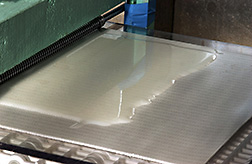Edible, Water-Resistant Film from Milk Protein
|
|
A new process to continuously make films from a milk protein could lead to edible, water-resistant coatings on several products commonly found in grocery-store dairy aisles.
The process uses the unique characteristics of casein (pronounced KAY-seen), a milk protein that is the chief nutritional ingredient in cheese. It is also used as a food supplement and as a functional component in nonfood products, including adhesives, finishing materials for paper and textiles, and paints.
Casein’s natural structure gives it the ability to form water-resistant and biodegradable films or coatings. Casein films could be produced as stand-alone sheets or as thin coatings that could adhere directly to a product. Either form would act as a barrier to outside substances while protecting a product from damage or contamination. The edible film locks in moisture, so it may be used to coat dairy food products, such as cheese, or as part of a laminate in packaging for cottage cheese or yogurt. Flavorings, vitamins, or minerals could also be added to the coatings.
The process uses an ARS-patented method developed by Peggy Tomasula, research leader in ERRC’s Dairy Processing and Products Research Unit in Wyndmoor, Pennsylvania. Her extraction method separates casein from milk with high-pressure carbon dioxide.
Tomasula found that if this casein is mixed with water and glycerol and left undisturbed to dry, it forms a water-resistant, flexible, filmlike material.
“It’s been difficult to obtain films, fibers, and molded materials with acceptable mechanical properties from casein,” Tomasula said. “That’s because moisture can dissolve it. The new material remains intact when exposed to water, unlike other protein-based films patented in the past.”
And until now, it hasn’t been known how to make such films on a continuous, large scale.
Michael Kozempel, who recently retired as a chemical engineer from ERRC, and Tomasula developed a pilot-plant process to produce the film continuously. Kozempel determined which feeding mechanism would spread the casein solution uniformly and which belt material would allow easiest removal of the dried films. He also specified drying conditions and temperatures for making the films in 3 hours.
“This process makes the films continuously, and it can be modified for other proteins,” Kozempel says. “It establishes the feasibility of commercial production of biodegradable polymer coatings made from dairy products.”
Kozempel also showed that up to 20 percent of the casein can be substituted with nonfat dry milk, which reduces the cost of the films with little loss in physical properties.
ARS has filed a patent application on the continuous-production process and is interested in finding business partners to move it to market.—By Jim Core, Agricultural Research Service Information Staff.
This research is part of Quality and Utilization of Agricultural Products, an ARS National Program (#306) described on the World Wide Web at www.nps.ars.usda.gov.
Peggy Tomasula is in the USDA-ARS Dairy Processing and Products Research Unit, Eastern Regional Research Center, 600 East Mermaid Ln., Wyndmoor, PA 19038; phone (215) 233-6703, fax (215) 233-6795.
"Edible, Water-Resistant Film from Milk Protein" was published in the November 2005 issue of Agricultural Research magazine.







